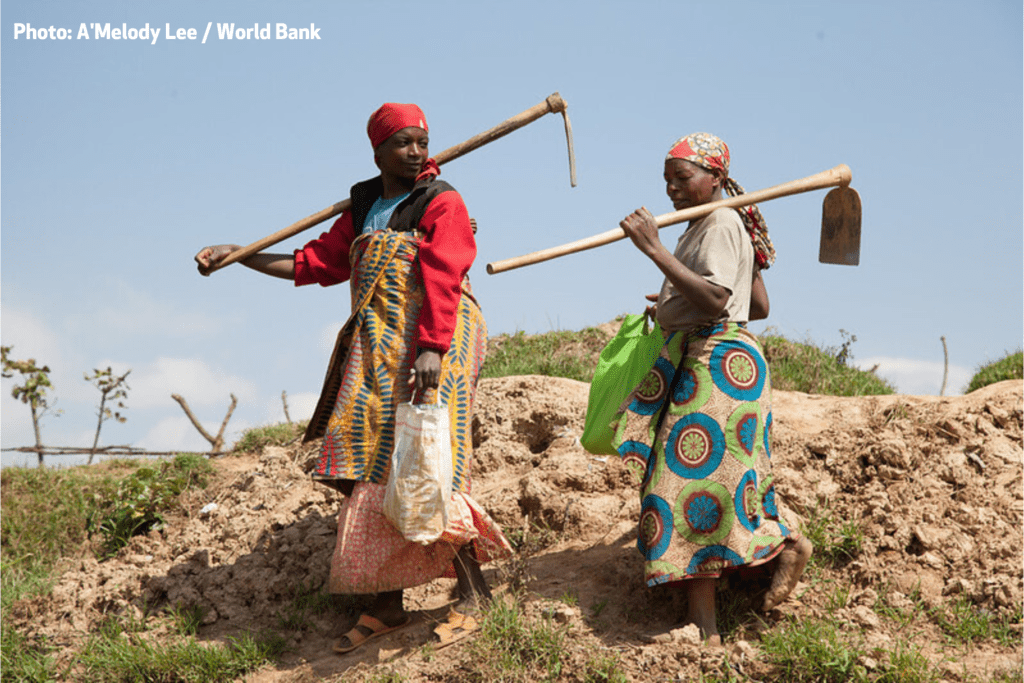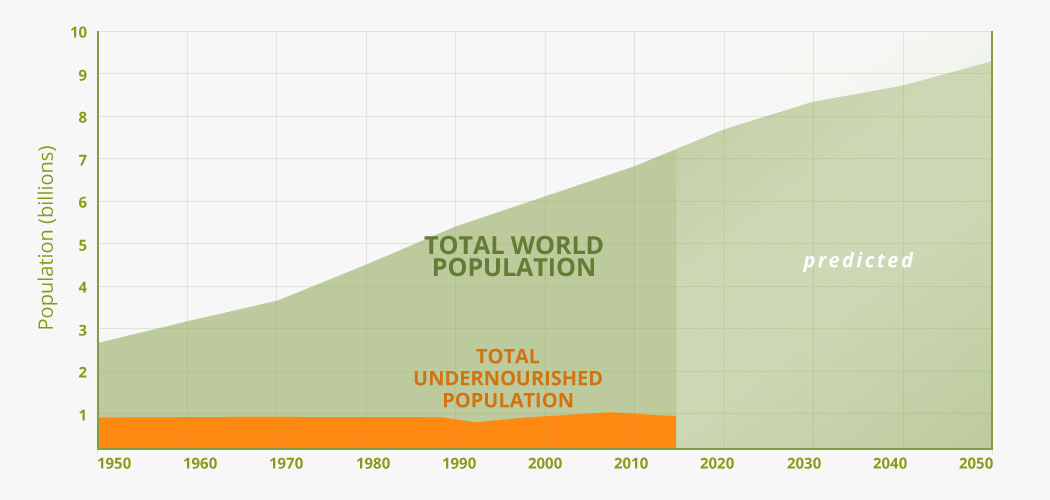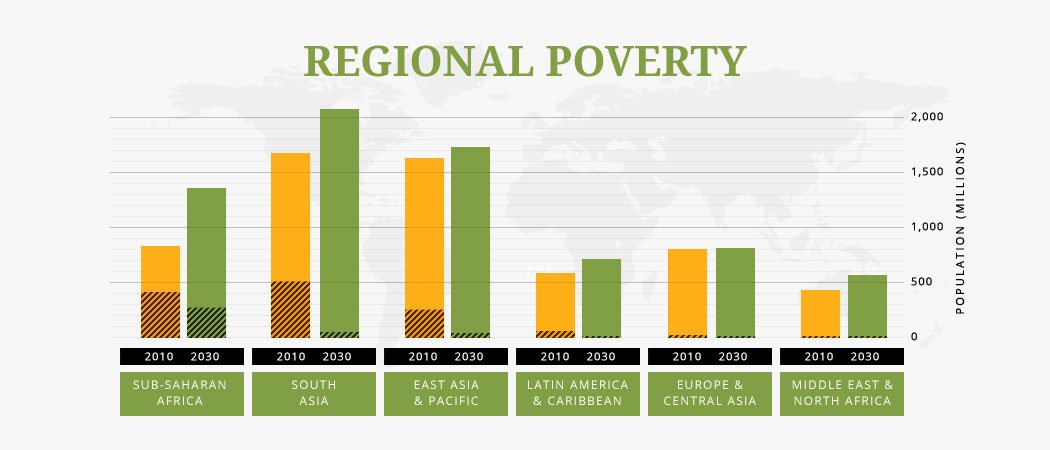
The Story of Agriculture and the Sustainable Development Goals (SDGs)
A Case Study By:

Part 1:
Hunger, Malnutrition,
Sustainable Agriculture

Sustainable Development Goal #2 calls specifically to:
“end hunger, achieve food security and improved nutrition and promote sustainable agriculture.”
To fulfil this goal, the United Nations has identified a series of specific targets (see 2.1-2.5), as well as the means of implementation (see 2.a-2.c) for reaching them.
Explore Goal 2 in depth here:
Hunger
2.1. “by 2030 end hunger and ensure access by all people, in particular the poor and people in vulnerable situations incuding infants, to safe, nutritious and sufficient food all year round”
Modern agriculture has achieved much over the past century. While the global population has grown from less than three billion people in 1950 to more than eight billion people today, global levels of hunger have not followed this trend, remaining largely constant over the same period.

The number of people affected by hunger globally rose to as many as 828 million in 2021, with around three quarters living in rural areas and are overwhelmingly dependent on agriculture for their food and livelihoods. Here’s a breakdown, by region, of where hunger still impacts the most:




Tackling hunger is not only about boosting food production; it’s also about increasing incomes and strengthening markets so that people can access food even if a crisis prevents them from growing enough themselves.
The Food and Agriculture Organisation of the United Nations has warned that with just eight years remaining to end hunger, food insecurity and all forms of malnutrition, the world is moving in the wrong direction, with sub-Saharan Africa as a region and rural women as a demographic group most at risk.
Malnutrition
2.2. “by 2030 end all forms of malnutrition, including achieving by 2025 the internationally agreed targets on stunting and wasting in children under five years of age, and address the nutritional needs of adolescent girls, pregnant and lactating women, and older persons”
Food security is not only about addressing hunger, but also about ensuring proper nutrition. Achieving nutrition security is about receiving the right quantity, quality and diversity of food in one’s diet.




Agriculture can play an important role to address malnutrition in three ways:
- Biofortified foods, such as vitamin-A enriched rice or sweet potatoes, are bred to have higher amounts of micronutrients and can help provide essential vitamins and minerals.
- Micronutrient-enriched fertilizers improve soil fertility, helping to support higher yields of more nutritious food and can combat micronutrient deficiencies in humans.
- Improved agronomic practices can also help, for instance crop rotation and conservation tillage by encouraging food diversity and preventing nutrient depletion of soils.
Productivity and incomes
2.3. “double the agricultural productivity and incomes of small-scale food producers, in particular women, indigenous peoples, family farmers, pastoralists and fishers, including through secure and equal access to land, other productive resources and inputs, knowledge, financial services, markets and opportunities for value addition and non-farm employment”
Agricultural development is inextricably linked to economic growth that benefits the poor. In fact, the World Bank has estimated that agriculture development is about two to four times more effective in raising incomes among the poorest than growth from any sector (and up to 11 times more effective in sub-Saharan Africa).
More than three-quarters (77%) of the increased food we will need to produce by 2030 needs to come from increased productivity.

Increased productivity, when coupled with better access to markets, can help address hunger directly at the farm level or provide sufficient additional income to buy food at market. For instance, the agricultural sector accounts for one-third of gross-domestic product (GDP) and three-quarters of employment in Sub-Saharan Africa.
As the graph below indicates, most of the population growth up through the year 2030 will occur in sub-Saharan Africa and South Asia. And while the latter is expected to nearly eliminate extreme poverty, it is set to persist on the African continent.

Sustainability and resilience
2.4. “ensure sustainable food production systems and implement resilient agricultural practices that increase productivity and production, that help maintain ecosystems, that strengthen capacity for adaptation to climate change, extreme weather, drought, flooding and other disasters and that progressively improve land and soil quality”
Agriculture is more vulnerable to climate change than any other sector. A warming climate could reduce crop yields by more than 25%, according to the World Bank.

Making agriculture more resilient in the face of climate change will be important, and thankfully there are many ways how to make this happen – from investing in drip irrigation and soil health to promoting disaster preparedness. (Explore the animated series ‘Resilience in Agriculture’ produced by Farming First and the International Food Policy research Institute for more.)
Agriculture and land use change are also responsible for between 19–29% of global greenhouse gas emissions. But the sector can also help to substantially mitigate against future greenhouse emissions, especially by increasing productivity of land already under cultivation and thus reducing deforestation. A higher price of carbon can help incentivise agriculture’s mitigation potential.
More productive farms also tend to use less water per unit of crop produced. Innovations such as drip irrigation can also improve agriculture’s water use efficiency while still supporting higher productivity.
Reducing food waste is another area which can improve the sustainability and resilience of the agricultural sector. It is estimated that one third of all food produced is never consumed, at a total cost as much as $1 trillion a year and account for about 8-10% of the total greenhouse gases released annually. Reducing consumer food waste by 20%-25% by 2030 could save the world an estimated $120-$300 billion a year. By 2030, this consumer food wasted could account for approximately $1.5 trillion in lost revenue.
Investment
2.a. “Increase investment, including through enhanced international cooperation, in rural infrastructure, agricultural research and extension services, technology development and plant and livestock gene banks in order to enhance agricultural productive capacity in developing countries, in particular least developed countries”
There is general consensus that investing in rural public goods (such as roads, power, irrigation, education, health, water, agricultural research and extension) is one of the best ways to support agricultural production and livelihoods.
A total of $239 billion invested over the next 15 years, in road and railway connections to connect farms to markets and in electricity supplies to improve cold storage, would yield benefits of $3.1 trillion by safeguarding food.
And smallholder farmers play a key role, as they hold as much as 75% of the global seed diversity in staple food crops, with the rest being held in gene banks.
Urgent action will be needed, since as much as 10% of the biodiversity seen in 2000 may be lost by the year 2030, resulting from land lost to infrastructure as well as from agriculture and climate impacts.
Investments in crop yield improvement have also positively impacted agriculture’s greenhouse gas emissions. In fact, every dollar invested in agriculture has resulted in a reduction of 68kg of emissions. Over time, these productivity gains have saved an estimated 161 gigatonnes of carbon emissions, or roughly one-third of total human emissions to date.

Because farming is a knowledge-intensive occupation, this research must also be brought to farmers through improved access to extension services, especially for women farmers.
Overall, the United Nations has calculated that net investments of $83 billion a year must be made in agriculture in developing countries in order to meet expected food demand by the year 2050.
Trade
2.b. “Correct and prevent trade restrictions and distortions in world agricultural markets, including through the parallel elimination of all forms of agricultural export subsidies and all export measures with equivalent effect, in accordance with the mandate of the Doha Development Round”
More open and fair agricultural trade systems can make everyone better off. Trade allows food to flow from areas of surplus production to areas of deficit production.
In addition to increasing the flow of food products, effective trading systems allow the most appropriate technologies, inputs, machinery, finance and know-how to to be used. Trade can help drive pro-poor economic growth much more sustainably by encouraging investment and allocating resources more efficiently than foreign aid.
Higher farm incomes benefit farmers themselves, but also spur additional growth in the non-farm rural sector as well as lowering food prices for the urban poor.
For smallholders in Africa, this growing urban market is expected to offer 15 times the market potential than commodity crops or high-value export crops.

Commodity markets
2.c. “adopt measures to ensure the proper functioning of food commodity markets and their derivatives and facilitate timely access to market information, including on food reserves, in order to help limit extreme food price volatility”
When price fluctuations occur quickly, farmers and other suppliers cannot plan accordingly or react quickly enough to meet demand easily.
In these instances, governments may respond by banning or restricting food exports or amassing huge food reserves out of fear shortages, whether real or perceived, and to protect national security interests. These measures can drive prices up even higher, especially when information on global food reserves is not readily available.

Effective commodity markets can help limit price volatility and work to get farmers the best price for the crops they grow. For example, the Ethiopian Commodity Exchange (ECX) was set up in 2008 to create such a marketplace. They help to assure the quality and quantity of goods for buyers while also facilitating payments and delivery on behalf of sellers through a network of warehouses and regional offices.
In 2011, the Agriculture Ministers of the G20 also established the Agricultural Market Information System (AMIS) to encourage more transparency in global food markets and a coordinated response to future uncertainty. It monitors market trends, collects key data and engages in training workshops and policy dialogue in order to reduce the likelihood of extreme price fluctuations in the future.
Part 2:
Agriculture Across
the SDGs

Reaching the SDG targets simply will not be possible without a strong and sustainable agricultural sector.
More than just its direct impact on hunger and malnutrition, our food system is also linked to other development challenges being addressed in the SDGs.
Explore agriculture’s connection to many of the 17 SDGs here:
Poverty alleviation
Rural people represent the largest segment of the world’s extreme poor by far – more than 80% of the total. Growth in agriculture is at least twice as effective in reducing poverty than from any other sector.
Education
Agricultural extension enables farmers to access to the skills, tools, inputs and knowledge they need to thrive.
Gender equality
Women farmers produce 20-30% less than their male counterparts, mostly due to differences in their access and use of resources. Women produce over half the food worldwide, so bridging this gap could reduce global hunger by as much as 17%.
Energy use
By 2030, energy demand is expected to increase as much as 50%, driven mostly by developing world demand. More crops are likely to be diverted for use as biofuels, doubling or even tripling as a proportion of total use.
Economic growth and employment
Agriculture is an engine of pro-poor economic growth in rural areas. Entrepreneurship across the rural and food sectors can generate employment and growth. Find out for whom…
Sustainable consumption and production
Average per capita consumption is expected to grow through 2030, despite population increases. At the same time, around one third of food produced is wasted.
Climate change
By 2030, agriculture’s carbon mitigation potential could reach as much as 7.5% of total global emissions, depending on the price of carbon and adoption of agricultural productivity measures.
Part 3:
Additional Resources

Help spread the word about agriculture’s importance in the SDGs.
Use the resources here to learn more, follow the negotiations and plan your outreach:
Key Messages
- Placing sustainable agriculture, food security and nutrition as the second goal reflects their primacy.
- Achieving zero hunger means a focus on food and nutrition. If children are malnourished and their growth stunted in their first 1000 days their health is impacted for the rest of their life. Their capacity to build and shape their future can be irrevocably harmed. It starts with farming and touches every person on the planet.
- The indicators on the Post 2015 agenda must include hunger, nutrition, poverty, learning and sustainability issues so that agriculture can fulfill its role and potential within the SDGs.
- Investment in agriculture needs to grow from all actors. The L’Aquila commitments did not flow adequately and agriculture remains underfunded. It is the top priority in the means of implementation and it should be an indicator.
- Just as people-centred approaches are at the core of the development aspirations of the UN, agriculture programs need to be ‘farmer-centred and knowledge-based’ so that the full potential of farmers, both men and women, including small-holder and commercial farmers, can be harnessed in making food security and sustainable development a reality.
- Sustainable agriculture is knowledge-based and requires a holistic view. There is no “one-size-fits-all” solution in agriculture: The SDGs and Post 2015 process must reflect a broad diversity of farming systems: from livestock to crop; horticulture to agro-forestry; modern to traditional; co-operatives to businesses; smallholders to large.
- We need ALL partners at the table – governments, farmers, scientists, civil society and private sector – in financing and means of implementation discussions around the Sustainable Development Goals.
Key Resources
The SDG Negotiations:
- “The Road to Dignity by 2030: Ending Poverty, Transforming All Lives and Protecting the Planet”, Secretary General’s Synthesis Report, December 2014
- Outcome Document (Draft SDG text), UN Open Working Group
- Food Security and Nutrition / Sustainable Agriculture Thematic Cluster, UN Open Working Group
- Major Group Position Papers, UN Open Working Group
- Financing for Sustainable Development: Implementing the SDGs through Effective Investment Strategies and Partnerships, UN Sustainable Development Solutions Network
- Indicators and a monitoring framework for Sustainable Development Goals: Launching a data revolution for the SDGs, UN Sustainable Development Solutions Network
Food Security and Nutrition:
- “Agricultural development policy:a contemporary agenda” Overseas Development Institute (ODI)
- “ASTI Global Assessment of Agriculture R&D Spending” ASTI
- “Sustainable Intensification: A New Paradigm for African Agriculture”, Montpellier Panel, 2013
- “Small and Growing: Entrepreneurship in African Agriculture”, Montpellier Panel, 2014
- Biofortification: An Agricultural Investment for Nutrition, Global Panel on Agriculture and Food Systems for Nutrition
- Key Facts and Figures, World Health Organisation
- Anemia Policy Brief, World Health Organisation
- “Global Nutrition Targets 2025”, World Health Organization
- Online Library of White Papers and Reference Resources on Agriculture Innovation, Social Enterprise, Farm Finance, and Agriculture Policy, One Acre Fund
- Resources, Scaling Up Nutrition
- First 1,000 Days Learning and Development Toolkit, GAIN Health
- 5 Conditions to Destroy Through Food Fortification, GAIN Health
- Fertilizing Crops to Improve Human Health: A Scientific Review, IFA & IPNI
- Resources, CGIAR Research Program on Agriculture for Health and Nutrition
Markets and Trade:
- Leaping & Learning: Linking Smallholders to Markets, Agriculture for Impact, 2013
- 8 Views for the G8: Buisiness Solutions for African Smallholder Farmers, Agriculture for Impact, 2013
- Position Papers, International Food & Agriculture Trade Policy Council
- Policy Briefs on Rural Development, International Labour Organization
- Rural Youth Employment in Developing Countries: A Global View, Food and Agriculture Organization of the United Nations
Sustainability and Resilience:
- “No Ordinary Matter: Conserving, Restoring and Enhancing Africa’s Soils”, Montpellier Panel, 2014
- ‘Growth with Resilience: Opportunities for African Agriculture’, Montpellier Panel, 2012
- Building Resilience for Food and Nutrition Security, IFPRI 2020 Policy Consultation & Conference, 2014
- “Fact Sheet on Extension Services”, Global Forum for Rural Advisory Services
- “Mainstreaming Disaster Risk Reduction in Agriculture”, FAO, 2014
- The Global Alliance for Climate Smart Agriculture, FAO
- Publications, CGIAR Research Program on Climate Change, Agriculture and Food Security
- Climate Smart Agriculture: Helping the World Produce More Food, World Bank







